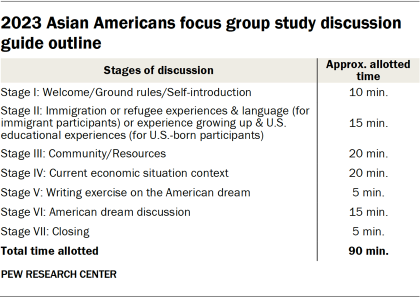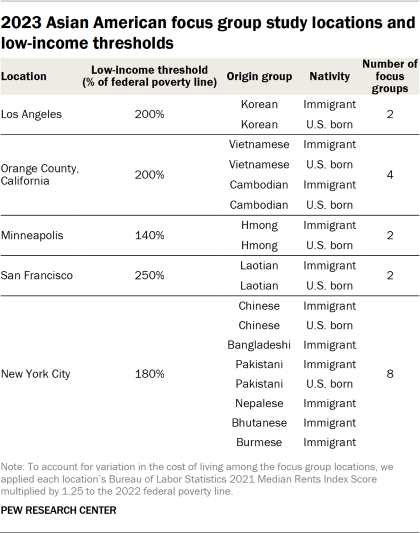Pew Research Center created and designed this focus groups plan to understand the experiences and perspectives of Asians living with economic hardship in the United States. The analysis presented in this data essay provides insight into these topics and is not an exhaustive representation of public opinion on these topics or of specific demographic groups.
This research was conducted by PSB Insights for Pew Research Center and was reviewed by an IRB (internal review board) for human subject research.
About the focus groups
Pew Research Center conducted 18 in-person focus groups with 144 adult participants from across the United States from Feb. 7 to Feb. 23, 2023. Recruited participants are from 11 Asian origin groups. Each person was offered an incentive amount of $225 to participate. Focus groups were 1.5 hours in length. Guides for immigrant Asian focus groups were translated into 11 non-English languages. (Read the moderator guide for more.)
The topics for discussion and approximate allotted time during the focus groups were as follows:

Study design and group criteria
For each focus group, 10 participants were recruited and eight were ultimately selected to participate. The research team overrecruited participants to account for “no-shows,” as well as participants who may experience other issues preventing participation.

The study included focus groups from 11 distinct Asian origin groups. These are among the most likely Asian origin groups to live in poverty in the U.S. in 2019. These included participants from three (Chinese, Korean and Vietnamese) of the six largest U.S. Asian origin groups. The study also included participants from eight less populous origin groups (Bangladeshi, Bhutanese, Burmese, Cambodian, Hmong, Laotian, Nepalese and Pakistani). These ethnic origin groups were selected to include voices of those from smaller populations.
Focus groups were further stratified by nativity for selected origin groups. Researchers classified participants into either “U.S. born” or “immigrant” focus groups based on self-reported birthplace and immigration information provided in the screener survey.
Participant recruitment procedures
Recruitment of focus group participants was conducted via local Asian community member networks, organized by language and ethnicity. Recruitment was conducted in person following guidance on COVID-19 restrictions (i.e., personal visits, community meetings, etc.), via social media (e.g., Facebook, Line, WeChat, WhatsApp) or by phone or email.
All potential participants were screened for eligibility based on a questionnaire designed by Pew Research Center, which included criteria such as ethnic origin affiliation, country of birth, length of time in the U.S. (for immigrants), household income and other demographic profile questions. Once eligible participants were identified, they confirmed if they were available for the focus group and signed an informed consent form.
All participants had to meet the following five criteria to be eligible to participate:
- Live within or near the states corresponding to where the research was conducted (California, Minnesota/Wisconsin, New York/New Jersey).
- Belong to the ethnic origin group of the respective focus group audience and fluently speak the language the group was conducted in.
- Be between the ages of 25 and 59.
- Have a household income that qualified them as low income for the purposes of this study – defined as earning a maximum household income of 140%-250% of the federal poverty line. Thresholds varied by recruitment city to account for differences in the cost of living.
- Meet “soft quotas” set for the demographic characteristics of gender, education and location of birth to ensure a diverse mix of participants within each focus group. (Soft quotas are flexible recruitment targets that can be adjusted based on realities of recruitment and sample target.)
In order to qualify for the U.S.-born groups, participants had to have been either:
- Born in the U.S., or
- Born outside the U.S., but arrived in the country before the age of 7.
To qualify for the immigrant group, participants had to have been either:
- Born outside the U.S. and arrived in the country after the age of 15, or
- Born outside the U.S., arrived in the U.S. between the ages of 7 to 15, and were determined to be connected to the culture of their home country to a degree similar to people born outside the country and immigrated to the U.S. after age 15. This determination was based on a series of questions decided upon by the research team.
These questions asked about whether they consume media in English or their native language; how often they participate in holidays and practices associated with their origin country; how well they remember growing up in their origin country; and how many of their friends are Asian but of a different ethnicity than theirs.
Respondents were invited to participate in the immigrant focus group only if their answers to at least three of the four questions were considered similar to those who immigrated after age 15 (i.e., they consume media in their native language more often or equally as often as in English; participate in their origin country’s holidays and practices very or somewhat often; remember growing up in the origin country very or somewhat well; and at least some of their friends are Asian but of a different ethnicity).
All focus groups were conducted in person. The table below details locations, which Asian origin groups were recruited, and low-income thresholds applied.

Eligible participants were identified by PSB and then reviewed and approved by the Pew Research Center team for participation. For each focus group, researchers selected eight preferred participants from the 10 recruited participants, ensuring diversity across dimensions for which there were no hard quotas, including gender, educational qualifications and partisan identification. If one of the eight preferred participants did not show up to the focus group or experienced other difficulties to the extent that they could not participate, they were replaced by one of the two overrecruited participants. When replacing participants, the research team strove to keep the groups as diverse as possible with a special emphasis on maintaining gender parity.
Moderator and interpreter qualification
PSB Insights partnered with GC Global to help facilitate focus group moderation and interpretation. Recruitment for focus group moderators emphasized the importance of having native language speakers as well as matching moderators’ ethnicity to each origin group. This would help build rapport and facilitate an open conversation with participants. All moderators were briefed on the discussion guide and research objectives prior to the focus groups by PSB Insights. For less experienced moderators, an additional moderator training session was provided.
The research team also hired interpreters to provide on-site simultaneous translations when immigrant focus groups were conducted.
Data analysis
Focus group conversations were video recorded. All conversations were transcribed, translated if conducted in a non-English language and checked for transcription errors. To analyze the focus group transcripts, Center researchers used ATLAS.ti, a qualitative data analysis and research software.
All 18 focus group transcripts were coded using the following structure for individual participants within each focus group:
- Origin group
- Nativity
- Age group
- Gender
- Education
- Employment status
- Immigration generation
- Years in the U.S. (for immigrant participants)
The transcripts were also coded by topic, including but not limited to:
- Current economic situation
- Communities and resources
- The American dream
- Immigration experiences (for immigrant focus groups)
- Experiences growing up (for U.S.-born focus groups)
Within each topic, we used a list of detailed codes to identify the theme of each response. For example, the research team used the following codes to label responses related to discussions on attitudes toward reaching the American dream:
- The American dream is easy to achieve
- (code label: “American dream: easy to achieve”)
- The American dream is hard to achieve
- (code label: “American dream: hard to achieve”)
Several quality control checks were conducted. After coding all transcript documents, researchers viewed organized quotes with demographic codes alongside them. A different researcher then evaluated the codes and made suggestions for changes. Any discrepancies were resolved between the primary coding researcher and the reevaluating researcher. When they could not reach an agreement, the lead researcher would reconcile the coding and set standardized coding practices for similar quotes.
The finalized quotations were exported by research topics into a spreadsheet where each row represented one quote. The research team identified the themes within each detailed topic code and rearranged and extracted quotations into different themes for publication.
While we highlight the sentiments expressed by individual participants in the data essay, they are chosen to highlight the themes discussed by the group more broadly. They are not necessarily representative of the majority opinion in any group.
Quotations in the data essay have been lightly edited for grammar, spelling and clarity.




